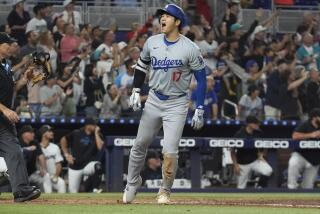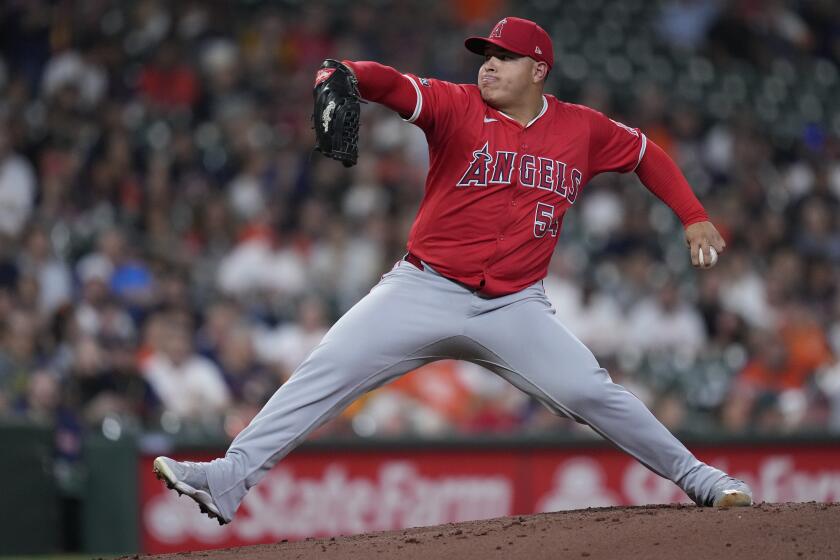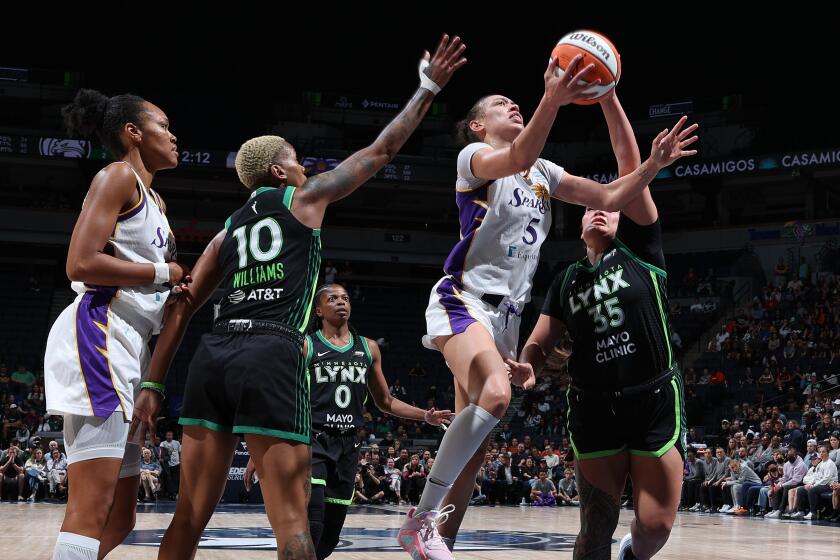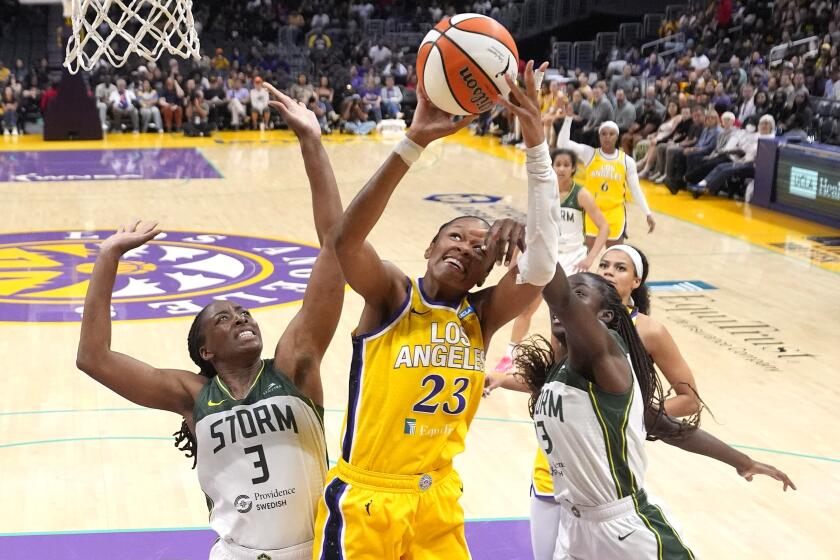Losing track of a special time
Panning across a vacant strip of asphalt and empty grandstands, a homemade video clip on YouTube.com shows the now silent Los Angeles County Raceway, a drag strip in Palmdale that closed this summer.
It’s a requiem for a wind-swept parcel of land that presented drag racing for more than 40 years, a track that outlasted -- until now -- the march of progress that long ago doomed most other such venues.
But a generation ago Southern California was a drag racing capital, with nearly a dozen quarter-mile drag strips from Saugus to Long Beach at various times between the early 1950s and early 1980s. It was drag racing’s golden era for many fans, with mostly grass roots racing and celebrated drivers with nicknames such as Don “The Snake” Prudhomme and Tom “The Mongoose” McEwen.
“California was the hub of what was happening in drag racing,” said Tom Madigan, a former racer who chronicled the area’s racing history in a book this year, “Fuel & Guts: The Birth of Top Fuel Drag Racing.”
Then there was the outsider they all feared, “Big Daddy” Don Garlits, a Floridian who wasn’t particularly big in size but whose black “Swamp Rat” dragsters often humbled local drivers on his frequent trips to Southern California.
The region’s drag racing heritage comes to mind as the sport’s top professional drivers return to Pomona this weekend for the season finale of the National Hot Rod Assn.’s premier circuit, the Powerade Series.
The Auto Club Raceway in Pomona is among the few surviving drag strips in Southern California because it remains to pro drag racing what Indianapolis is to Indy-style race cars and Daytona Beach are to NASCAR. The only others left are a drag strip at the California Speedway in Fontana and a one-eighth-mile strip at Irwindale Speedway. Another survivor is the Auto Club Famoso Raceway in Bakersfield.
Otherwise, the drag strips that once featured mostly amateurs racing in Long Beach, San Gabriel, Colton, San Fernando, Orange County and other Southern California cities are long gone, squeezed out by surging population and land that became too valuable for the sport’s nitro-burning, tire-squealing cars and were too noisy for ever-encroaching homeowners.
“It was urban sprawl,” Garlits, now 75, said on a recent visit to the Famoso track for a drag racing reunion. “It’s not the same as it was when we were getting going in the ‘60s, when there was a drag strip in every little town, practically.”
Drag racing took hold here after World War II, when returning soldiers and others with a few extra bucks and a love of racing built cars they initially ran on dry lake beds. As the hot-rod culture took root in Southern California in the early 1950s, drag racing blossomed as public drag strips began opening, with plenty of land and weather that supported year-round racing.
“At the dry lakes, it was hot, dusty and a long way from here,” said Greg Sharp, curator of the NHRA Wally Parks Motorsports Museum in Pomona. “At the [local] drag strip you could go every weekend and your car didn’t get filthy dirty.”
Whether it’s coincidence, as the drag strips have disappeared, the number of accidents and arrests related to illegal street racing has become a major problem in Southern California.
Some former drag strips in Southern California were opened 50 years ago, at least in part, to get the kids off the streets.
One of the region’s most popular old strips was Lions, just outside the Long Beach city limits. It was started in 1955 by several chapters of Lions civic clubs, a Long Beach judge and a manager named Mickey Thompson so that people would have a legal place to race. Lions quickly became one of the drag racers’ tracks of choice, and Thompson would later become one of Southern California’s leading motor sports promoters.
“Each drag strip had its own specific character,” Madigan said. “That was important to the guys who ran them. Like Long Beach. You didn’t have any nerve if you didn’t run Long Beach. It had a mystique about it.
“It’s kind of hard to describe, but that drag strip became hallowed ground,” he said. “You could smell the oil from the nearby refineries, you could feel the smog.”
All the drag strips enabled drivers of modest means to keep racing, and gave fans the opportunity to see flame-spewing, ultra-loud dragsters up close for an admission of $2 to $5. “We ran Long Beach one day and the next day San Fernando,” said Tony Waters, 80, a drag-racing pioneer who also attended the reunion at Famoso. “Back in those days the drag strips were everywhere, and everybody could afford it.”
Sharp said most racers “ran on a weekly basis and it was open to all-comers, anybody who wanted to come and try to race.”
“They would typically be racing for $500 cash or a $500 savings bond, something like that,” Sharp said. “But they were all mostly amateurs.”
In the late-1950s and early ‘60s, “guys actually started making a living running on Saturday nights and Sundays,” Madigan said. “They started making a grand here, two grand there. And back in ‘60-’61, you could live on a grand a month.”
In 1967, the sport hit its apex in the region with the opening of Orange County International Raceway in Irvine. Considered among the best drag strips ever built at the time, it featured modern grandstands, an electronic scoreboard and state-of-the-art timing technology.
But as the 1970s arrived, drag racing began changing and the surge in Southern California’s population and property values changed the landscape for drag strips too.
Before then, the most popular form of dragster was the top-fuel car, which had a tiny cockpit in the rear over enormous tires. The supercharged engine and transmission, and a long, spindly chassis, were in front.
But after losing part of a foot when his transmission exploded in 1970 at Lions, Garlits designed the rear-engine top-fuel dragster that revolutionized the sport and is still used today. (One of his cars sits in the Smithsonian Institution.)
The new design enabled dragsters to go well over 200 mph, and corporate sponsors were increasingly drawn to the growing sport.
The introduction of “funny cars,” dragsters that had a complete body over the driver, engine and chassis, drew even more sponsors. Their involvement, and the costs of building cars that could keep reaching ever-higher speeds, started lifting the cost of drag racing beyond the reach of many.
“It was just too expensive,” said James Warren of Bakersfield, another former driver who attended the Famoso reunion. “That’s why we had to drop out. I had to either quit my job and tour, or work. I had to work.”
Simultaneously, many tracks could no longer survive the noise complaints, rising land values and higher insurance costs related to the soaring, more dangerous speeds.
San Fernando closed in 1969, Lions in 1972 and the first Irwindale drag strip closed in 1973. Even the more modern Orange County strip held its last race in 1983.
Southern California remains a hotbed for young men and women to customize their cars for either more speed or exotic looks, said Sharp, the museum curator.
But he’s not sure they appreciate how drag racing -- on sanctioned, commercial drag strips -- was once so popular in the area.
Today’s car buffs hold shows next to the museum, he said, “and not one of them comes in here because they don’t have a clue that it connects with what they’re doing now.”
--
--
THIS WEEK
What: Automobile Club of Southern California NHRA Finals.
Where: Auto Club Raceway at Pomona.
When: Thursday-Sunday.
Tickets: (800) 884-6472.
More to Read
Go beyond the scoreboard
Get the latest on L.A.'s teams in the daily Sports Report newsletter.
You may occasionally receive promotional content from the Los Angeles Times.










